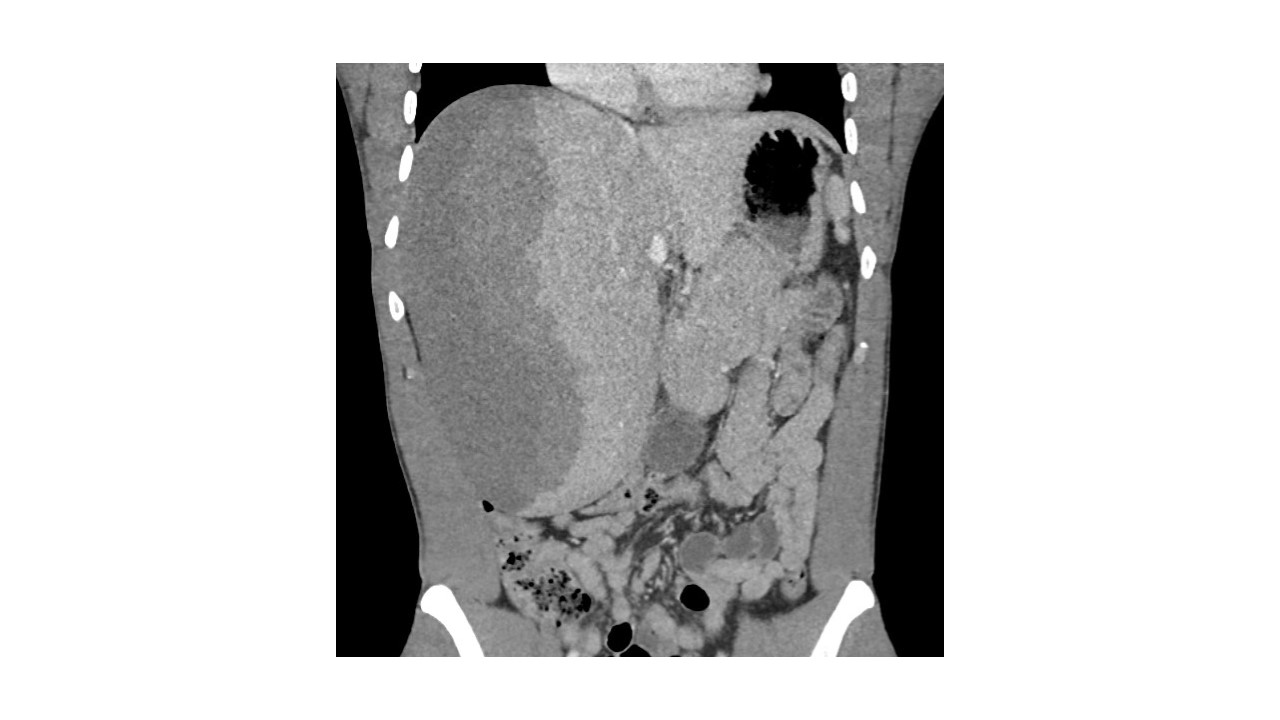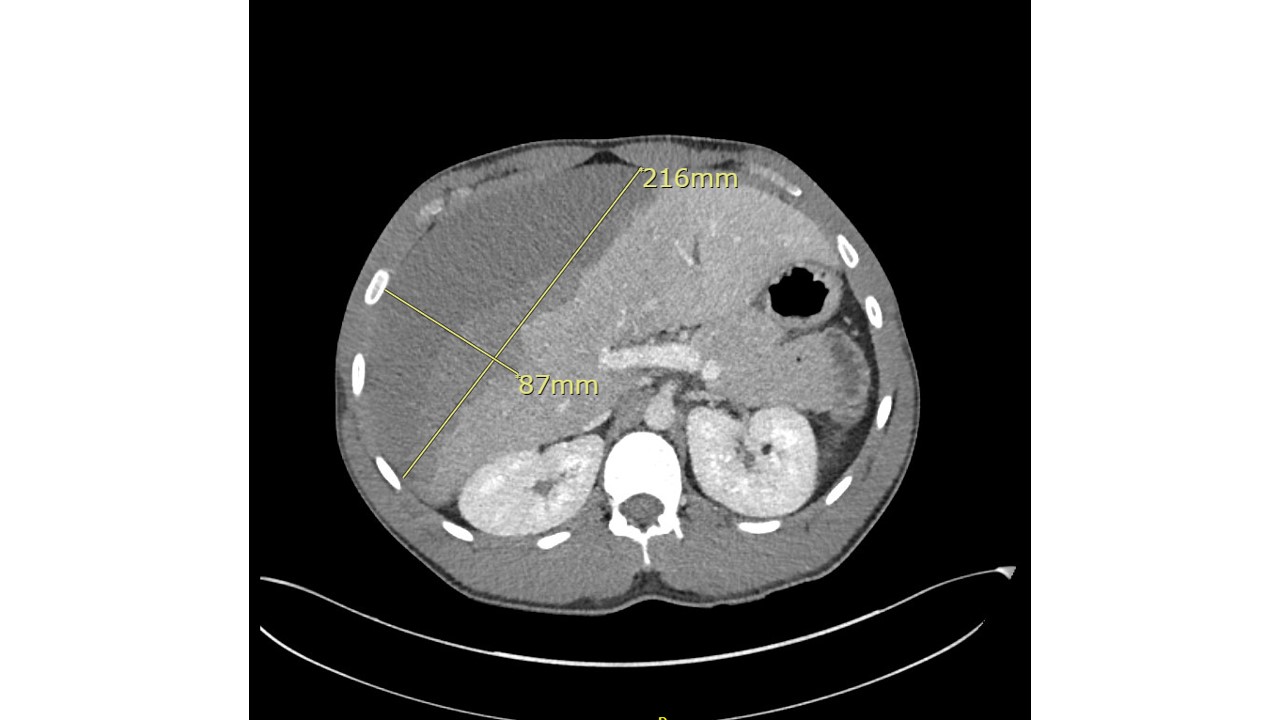Tuesday Poster Session
Category: Liver
P6132 - A Large Finding in a Young Bodybuilder
Tuesday, October 28, 2025
10:30 AM - 4:00 PM PDT
Location: Exhibit Hall

Amna Malik, MD
AdventHealth
Orlando, FL
Presenting Author(s)
Amna Malik, MD, Areeba Meraj, MD
AdventHealth, Orlando, FL
Introduction: We present a case of spontaneous formation of a large hematoma in a patient with no significant past medical history, highlighting a conservative management strategy.
Case Description/
Methods: 29-y male, bodybuilder, with a history of fatty liver disease and chronic cyclical testosterone use presented to the emergency (ER) due to severe abdominal pain, distention and nausea for one day and had syncopal episode in the ER, where an urgent CT abdomen w/IV contrast on the 1st day of hospitalisation, showed a massive subcapsular hematoma along the lateral aspect of the right hepatic lobe, measuring up to 26 cm, with evidence of focal area of active bleeding. He received 2 units of PRBC and was referred to our hospital for urgent arteriography.
He presented with tachycardia, a tense distended abdomen, tender on palpation in the right upper quadrant with hepatomegaly in our ER.
Initial workup revealed Leukocytosis, Hb 14.2, Platelet 357, creatinine 0.92, AST 110, ALT 165.
An arteriography with prophylactic embolisation was performed and revealed no active bleed.
His condition progressed, with increasing intra abdominal pressure and anuria and worsening transaminases and creatinine. A sudden drop in Hb to 7.9 necessitated a repeat IR guided angiography, resulting in gel foam embolisation of the ant branch of the right hepatic artery which was actively bleeding. A pseudoaneurysm was also visualised and embolized.
Clinical course improved with resolution of abdominal distension and normalisation of transaminases and creatinine. Most of the testing to uncover the possible cause of the hematoma was unfruitful.
MRI on the 8th day of hospitalisation showed a subscapular, large hematoma, roughly similar in size as prior imaging, along with ascites in the LUQ, pelvis, and a small right pleural effusion with atelectasis. He was discharged on the 13th day of hospitalization.
Discussion: Hepatic neoplasia, carcinoma and adenoma, have been cited as resultant pathologies of anabolic steroid abuse along with changes in vascular architecture and integrity. Trauma is a possible cause, as the liver is the most commonly injured organ in blunt abdominal trauma, but no such history was reported by patient. Additionally, we are unsure of any existing anatomic or structural abnormalities of the liver and its supplying arteries due to the lack of prior imaging. With most of the hepatology work up negative, it's difficult to say what triggered the bleeding leading to hematoma formation.

Figure: MRI

Figure: CTAP
Disclosures:
Amna Malik indicated no relevant financial relationships.
Areeba Meraj indicated no relevant financial relationships.
Amna Malik, MD, Areeba Meraj, MD. P6132 - A Large Finding in a Young Bodybuilder, ACG 2025 Annual Scientific Meeting Abstracts. Phoenix, AZ: American College of Gastroenterology.
AdventHealth, Orlando, FL
Introduction: We present a case of spontaneous formation of a large hematoma in a patient with no significant past medical history, highlighting a conservative management strategy.
Case Description/
Methods: 29-y male, bodybuilder, with a history of fatty liver disease and chronic cyclical testosterone use presented to the emergency (ER) due to severe abdominal pain, distention and nausea for one day and had syncopal episode in the ER, where an urgent CT abdomen w/IV contrast on the 1st day of hospitalisation, showed a massive subcapsular hematoma along the lateral aspect of the right hepatic lobe, measuring up to 26 cm, with evidence of focal area of active bleeding. He received 2 units of PRBC and was referred to our hospital for urgent arteriography.
He presented with tachycardia, a tense distended abdomen, tender on palpation in the right upper quadrant with hepatomegaly in our ER.
Initial workup revealed Leukocytosis, Hb 14.2, Platelet 357, creatinine 0.92, AST 110, ALT 165.
An arteriography with prophylactic embolisation was performed and revealed no active bleed.
His condition progressed, with increasing intra abdominal pressure and anuria and worsening transaminases and creatinine. A sudden drop in Hb to 7.9 necessitated a repeat IR guided angiography, resulting in gel foam embolisation of the ant branch of the right hepatic artery which was actively bleeding. A pseudoaneurysm was also visualised and embolized.
Clinical course improved with resolution of abdominal distension and normalisation of transaminases and creatinine. Most of the testing to uncover the possible cause of the hematoma was unfruitful.
MRI on the 8th day of hospitalisation showed a subscapular, large hematoma, roughly similar in size as prior imaging, along with ascites in the LUQ, pelvis, and a small right pleural effusion with atelectasis. He was discharged on the 13th day of hospitalization.
Discussion: Hepatic neoplasia, carcinoma and adenoma, have been cited as resultant pathologies of anabolic steroid abuse along with changes in vascular architecture and integrity. Trauma is a possible cause, as the liver is the most commonly injured organ in blunt abdominal trauma, but no such history was reported by patient. Additionally, we are unsure of any existing anatomic or structural abnormalities of the liver and its supplying arteries due to the lack of prior imaging. With most of the hepatology work up negative, it's difficult to say what triggered the bleeding leading to hematoma formation.

Figure: MRI

Figure: CTAP
Disclosures:
Amna Malik indicated no relevant financial relationships.
Areeba Meraj indicated no relevant financial relationships.
Amna Malik, MD, Areeba Meraj, MD. P6132 - A Large Finding in a Young Bodybuilder, ACG 2025 Annual Scientific Meeting Abstracts. Phoenix, AZ: American College of Gastroenterology.
